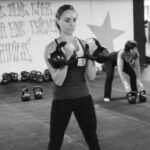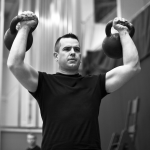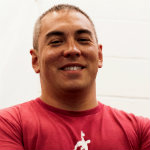The 2-1-3 workout is a complex made up of 2 cleans, 1 press, and 3 squats—with double kettlebells. It’s another beautifully simple creation of Dan John and it’s used as a SFG grad workout. When performed at the correct pace and with the appropriate sized kettlebells, it’s one of the best workouts I’ve ever done. The ratio of pull/push/squat and the order of the exercises is perfect. The workout can be done with or without a partner and there are multiple paths you can take for progression.
I will detail my progressions with the 2-1-3 at another time, but first I want to reiterate that this is done at SFG Certifications. It’s not for everybody.
Kettlebell newcomers should not be using double kettlebells until they’ve mastered the one-arm versions of each exercise. So, for newcomers, as well as others looking to build strength, the CPSq is a great workout.
The CPSq Kettlebell Workout
The CPSq is the one-arm equivalent to the 2-1-3 and it’s performed 1 clean, 1 press, 1 squat, switch hands. The CPSq is good:
- For technique work.
- If you don’t have pairs of kettlebells.
- If you want to get as strong as possible.
- As a warm up for the 2-1-3.
All you need is three progressively heavier bells in 4kg or 8kg increments with the heaviest bell being something you can press for 5-8 reps. Here is six-plus months of training you can do with them:
- Take 6 weeks to work up to 5 rounds with heaviest weight
- Take 6 weeks to work up to 5 rounds with heaviest weight, decreasing rest to 1:1
- Take 6 weeks to work up to 5 rounds with heaviest weight, no put-downs, performed as CPSq, CPSq, etc.
- Take 6 weeks to work up to 5 rounds with heaviest weight, no put-downs, performed as CCPPSqSq, etc. as shown in the video below.
Endless Ideas for Progressions
Simple workouts like the 2-1-3 and CPSq are great starting points. There are so many ways to build on them by manipulating sets, reps, resistance, and the work-to-rest ratio.
If you are familiar with programming, you could look at the six-week workouts above and see multiple ways to work through those weeks using ladders, straight sets, 5x5x5, 5-3-1, moving targets, and other approaches. There is no right or wrong way if you experience progression toward your training goals.
Likewise, if you are experienced with double kettlebells, you could progress from the 2-1-3, using the same progressions in the six-week cycles as above—cycling heavier weights, decreasing rest, no put downs, etc.
Here’s an example:
Here’s a couple possible targets to reach for after an SFG Cert. Some of these I have achieved and some I am still working on. Adjust your weights accordingly—and enjoy!
- CPSq x 48kg
- CPSq x 20rds 1:1 work:rest 2-1-3 x 48kgs
- 2-1-3 x 20rds 1:1 work rest








Hey just one questiion for my understanding
I really like this approach .. so 🙂
My max is a little above 24kg, so I should start with 16 K.
5 ronds starting CPSq left, then CPSq right … continuing with next round, I can do this very easily with 16 kg. 5 rounds without resting fairly easy
So, should I work on doing 5 x 5 rounds, as I obviously miss pressing volume?
Love this
Did 3rounds of it today doing CPSq no put down. How many rounds would you recommend before moving to CCPPSQSQ?
Sorry I mean 3 x5 rounds
Leif,
I’ve used this system during a powerlifting cycle where I used kettlebells once a week for conditioning/assistance work, and I’ve used it as the focus of my training and did it 3 times a week with varied intensity (ala Light, Med, Heavy). I’m sure you could do it more if you know what kind of volume your body responds well to.
Tank you for Your answer. I will try to do it 3 times a week.
How many times a week?
Hi Rob,
You could do it either way, CPSq 5 times and then switch hands, or CPSq switch hands and repeat 5 times. They will tax you in different ways. If you go with all 5 rounds in one hand before switching, I’d recommend that you start with your non-dominate arm. And yes, you might need a heavier bell, but try it with your 5RM first and let me know how it goes.
-Dan
Like Rob I was wondering this too.
I hope this isn’t too stupid a question, but to clarify – by 5 rounds, you mean CPSq on one arm, then the other, 5 times? It seems like I could do that quite easily to begin with if I was using a bell I could press 5 times, which is why I am confused… I am sure there is something I’m missing!